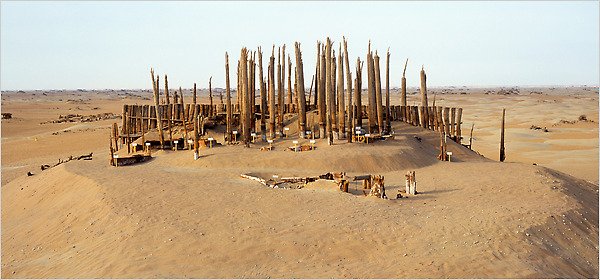In the middle of a terrifying desert north of Tibet, Chinese archaeologists have excavated an extraordinary cemetery. Its inhabitants died almost 4,000 years ago, yet their bodies have been well preserved by the dry air.
The cemetery lies in what is now China’s northwest autonomous region of Xinjiang, yet the people have European features, with brown hair and long noses. Their remains, though lying in one of the world’s largest deserts, are buried in upside-down boats. And where tombstones might stand, declaring pious hope for some god’s mercy in the afterlife, their cemetery sports instead a vigorous forest of phallic symbols, signaling an intense interest in the pleasures or utility of procreation.
The long-vanished people have no name, because their origin and identity are still unknown. But many clues are now emerging about their ancestry, their way of life and even the language they spoke.
Their graveyard, known as Small River Cemetery No. 5, lies near a dried-up riverbed in the Tarim Basin, a region encircled by forbidding mountain ranges. Most of the basin is occupied by the Taklimakan Desert, a wilderness so inhospitable that later travelers along the Silk Road would edge along its northern or southern borders.
In modern times the region has been occupied by Turkish-speaking Uighurs, joined in the last 50 years by Han settlers from China. Ethnic tensions have recently arisen between the two groups, with riots in Urumqi, the capital of Xinjiang. A large number of ancient mummies, really desiccated corpses, have emerged from the sands, only to become pawns between the Uighurs and the Han.
The 200 or so mummies have a distinctively Western appearance, and the Uighurs, even though they did not arrive in the region until the 10th century, have cited them to claim that the autonomous region was always theirs. Some of the mummies, including a well-preserved woman known as the Beauty of Loulan, were analyzed by Li Jin, a well-known geneticist at Fudan University, who said in 2007 that their DNA contained markers indicating an East Asian and even South Asian origin.
For the full story by NICHOLAS WADE, click here.

